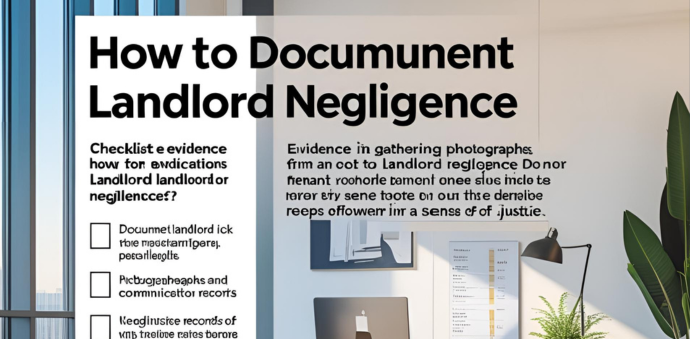How to Document Landlord Negligence: A Tenant’s Guide to Protecting Your Rights
Dealing with a negligent landlord can be frustrating and stressful, especially when repairs go undone or unsafe conditions persist. If your landlord is not fulfilling their obligations, properly documenting negligence is your strongest tool to protect your health, safety, and legal rights.
This blog post will guide you through effective ways to document landlord negligence, build a solid case, and take steps toward resolving your housing issues.
What Is Landlord Negligence?
Landlord negligence occurs when a landlord fails to maintain a rental property in a safe and habitable condition. This could mean ignoring repair requests, allowing health hazards like mold or pests to worsen, or neglecting essential utilities such as heat, water, or electricity.
When negligence threatens your living conditions or safety, it’s crucial to document everything carefully.
How to Document Landlord Negligence Effectively
- Start with clear photographic and video evidence. Take detailed, time-stamped photos and videos of all issues, such as broken fixtures, water damage, faulty wiring, mold growth, or structural problems. Capture different angles and include context, like the room or area affected.
- Keep a maintenance log or diary. Record every repair request you make, noting the date, time, method of communication (text, email, or call), and the landlord’s response or lack thereof. Mention any conversations or visits where the landlord promised repairs but did not follow through.
- Save all written communications. Preserve emails, text messages, letters, and notes from phone calls. Written requests and their responses establish a timeline of your efforts to get repairs done and your landlord’s negligence.
- Obtain professional reports if possible. A building inspector, electrician, mold specialist, or other licensed professional can assess and document hazardous or substandard conditions. Their impartial reports add credibility to your claim.
- Document health or financial impacts. If the landlord’s negligence has caused you harm or expenses like medical bills, damaged belongings, or temporary housing costs, keep receipts, invoices, and medical records.
- Create digital backups. Store all your evidence in multiple safe places, like email drafts, cloud storage, or external drives, so you never lose vital documents.
Why Is Documentation So Important?
Strong documentation allows you to prove your landlord’s negligence if you need to:
- Negotiate repairs or rent reductions
- File complaints with local housing or code enforcement agencies
- Use "repair and deduct" or other legal remedies in your state
- Break your lease legally if the property becomes uninhabitable
- Take legal action or sue for damages
What to Do After Documenting Negligence
- Notify your landlord in writing of the issues and request repairs. Include your documentation to show you are serious and organized.
- If your landlord ignores your requests, report the problems to local housing authorities who can inspect and enforce regulations.
- If necessary, consult a tenant rights attorney to explore your legal options. Having thorough documentation makes your case much stronger.
Don’t Let a Negligent Landlord Keep You Trapped
You deserve a safe and healthy home. If your landlord isn’t living up to their responsibilities, protecting yourself with clear, detailed documentation is the first crucial step.
Contact us today for a free consultation. Our tenant rights experts can help you gather the right evidence, understand your options, and take action to hold your landlord accountable. Don’t wait the sooner you act, the better we can protect your rights and your home.
Read: Landlord harassment laws – what are my rights?
